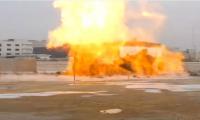LAHORE: The spread of lumpy skin disease (LSD) and other challenges including high cost of business have cast shadow on the otherwise flourishing tannery business.
The exports of leather goods that were projected to touch the mark of $1 billion, might hover around $950 million in 2021-22 due to supply crunch and price volatility of raw skins and hides over LSD and high cost of manufacturing.
Consequently, the lost glory of leather trade might be restored albeit at a slower pace, said stakeholders of tannery and leather businesses, while sharing an optimistic view of the sector.
After lifting of Covid-related restrictions, businesses have started showing progress. Leather sector exports grew by 17 percent in financial year 2021-22 compared to the last year.
With challenges of LSD and high cost of business, the exports would now likely remain between $950 million to $1 billion, observed Amanullah Aftab, Chairman, Pakistan Tanners Association (PTA).
He was of the view that lumpy skin disease spreads rapidly mainly in cow, which makes meat and skins of affected animals unusable. He emphasised that the raw hide of animals affected by LSD were totally unusable.
This definitely created negative impact on supply side directly or indirectly.
On the eve of qurbani or ritual of scarifying animals, he added, our hope of having an ideal season of sourcing skins and hides in big quantities has dampened to some extent. “Eidul Azha is the big occasion for tanning industry because we cover the raw hides and skins demand of around 4/5 months from animals slaughtered at qurbani,” he said.
Regarding price trend, he added, “this year we expect almost doubling of raw skin price”. Last year, the price of cow hide was Rs700 to Rs1,000 and goat skin stood at Rs150 to Rs180.
However, this year the price of cow hide would be around Rs1,600 to Rs2,200 and goat skin at around Rs250 to Rs350. Therefore, the cost of manufacturing on this count would be almost double than last year.
Being the third largest export industry, leather sector is one of the most important sectors for generating foreign exchange for country, he said, adding that the local industry manufactures very fine quality of finished leather that fetches a good price from world famous brands of shoes, gloves, leather garments and handbags.
Agha Saiddain, former Chairman, PTA also anticipated an adverse impact of LSD on the quality and quantity of skins this year. “There may be a drop in prices of cows for sacrificing on Eid and disease affected skins definitely will have no value,” he said.
On prices, he expected a jump on cow hides, from Rs1,200 to Rs1,800. Similarly, goat skins would likely be sold at an average price of Rs220 this year against last year’s price of Rs160.
Prof Dr Talat Pasha also echoed concerns about the deterioration of quality as well as quantity of raw cow skin to some extent due to LSD. He stressed the need to ensure blanket cover of immunisation to animals against LSD as soon as possible with a view to curtailing its spread.
To a question, he said, affected animal taking fodder, simply means loss in milk and meat production.
It should be noted that due to the second wave of Covid-19, low growth in export of leather was witnessed in the beginning of the outgoing financial year. With significant relaxations in lockdown at various destinations last year, business supplies of leather picked up, showing steady economic recovery.
The export of leather and leather products from Pakistan increased by 8.86 percent from $765.355 million to $833.199 million during fiscal 2020-21 over the preceding year. The outgoing year might likely see growth in leather exports as per stakeholders.
An image from the launch event of the Pakistan Pavilion for Expo 2025 Osaka's revelation in Kobe. —...
Federal Reserve Chair Jerome Powell. — AFP/File ARLINGTON: The recent tariffs introduced by President Donald...
Trucks loaded with shipping containers pass over Donghai Bridge to exit Yangshan Port outside of Shanghai, China,...
In this picture taken on July 20, 2023, a worker operates a machine preparing fabric at a textile mill in Lahore. —...
A hand is seen on a laptop with binary code displayed on the screen in front of Russian flag in this picture...
Traders work on the New York Stock Exchange floor in New York City, US on June 14, 2022. — ReutersLONDON/SINGAPORE:...







